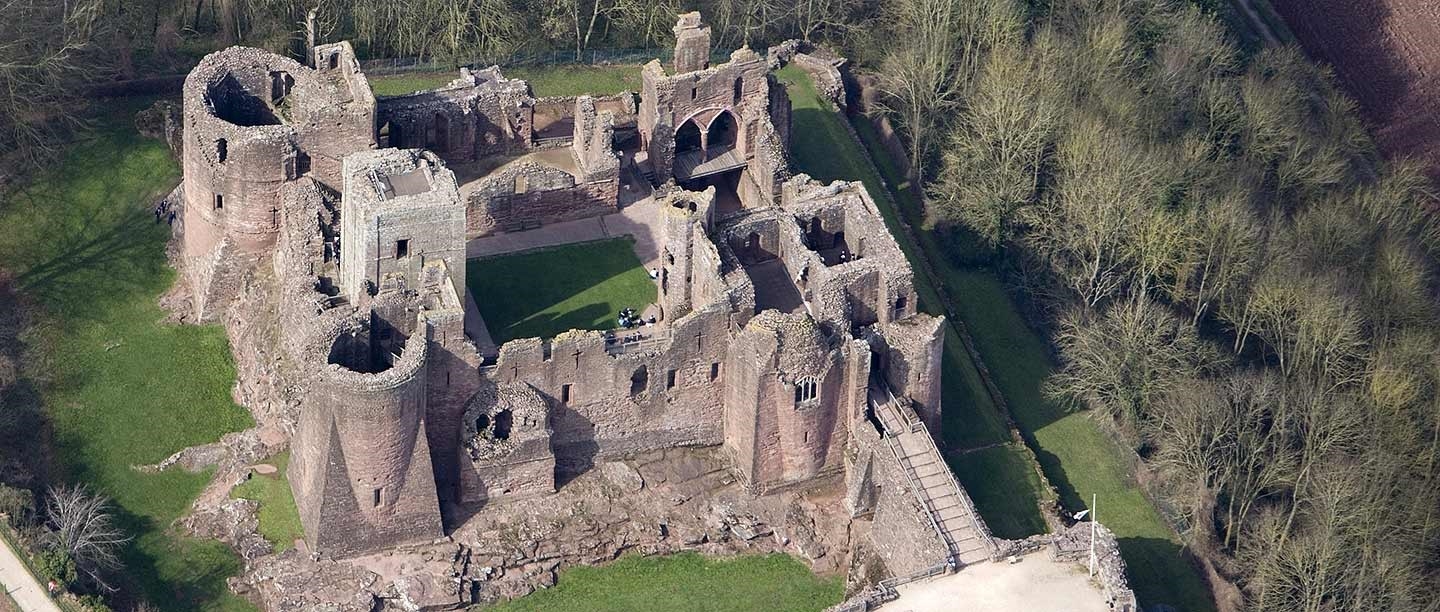The Outbreak of War
At the start of the Civil War, although support for the king in Herefordshire was strong, Goodrich Castle was garrisoned by Parliamentarians. They probably had the consent and help of Richard Tyler, the constable of the castle, who had been living at Goodrich since the early 1630s and had carried out many renovations there.
But in late 1643 the Parliamentarian garrison withdrew, and soon afterwards a Royalist garrison was billeted at Goodrich Castle under the command of Henry Lingen (1612–62). In September 1644 he made the castle his permanent headquarters.
This development saw the imprisonment of Richard Tyler, who had prudently tried to sell livestock and other property before it was requisitioned. The Royalist takeover was evidently violent, with the ‘burning and destroying’ of the farm buildings on the site of Flanesford Priory, immediately below the castle.
Parliamentarian gains
In the following year there was intense fighting when the Royalist city of Hereford came under siege from a Parliamentarian army. It was narrowly saved by a relieving army under the king's command, but on 18 December 1645 Parliament took the city. Henry Lingen, who was in Hereford at the time, managed to escape across the frozen river Wye. He headed for Goodrich Castle, which now became the centre of Royalist activity in the area.
Sir Henry, newly knighted by the king during the siege, had a garrison numbering as many as 120 soldiers and 50 officers and gentlemen, mostly local men who knew the area well. Under Sir Henry they carried out raiding operations in the surrounding territory. But with the rest of the county in Parliamentarian hands, an attack on Goodrich was bound to follow.
The raid on the stables
The local Parliamentarian commander was Colonel John Birch (1615–91), who had played a leading role in the capture of Hereford. His first ploy was to hamper the Royalist operations by depriving the Goodrich garrison of its horses.
On the night of 9 March 1646, a detachment of his men covertly entered the stables, which lay outside the main defensive ring of the castle. Under cover of darkness and a diversionary attack on the gates, the raiders climbed over the outer curtain wall and dug a hole in it. They captured the horses and led them away, then set the stables on fire. According to one description, 80 horses were kept there at the time.
This action, three months before the final siege of the castle, was a complete success and widely reported in Parliamentarian accounts. But though clearly a propaganda coup for Birch, it had little lasting effect. The Parliamentarian army embarked on other operations elsewhere, allowing the Royalists to replace some of the lost horses and resume their attacks around Goodrich. They even carried out a raid on Hereford in broad daylight.
Return to the castle
Birch returned to Goodrich on 1 June 1646, this time determined to accept nothing less than unconditional surrender. By now the outcome of the Civil War was clear – the king had been under house arrest since 13 May and the Royalist headquarters at Oxford was negotiating for surrender. But Birch and Lingen still had a score to settle.
The castle stands in an excellent defensive position – on the spur of a hill, and protected by a wide rock-cut ditch. But it was not prepared for 17th-century siege warfare. Storming the castle directly was not an option, so Birch ordered his forces to dig trenches to shelter his artillery under the walls.
An Exchange of Letters
Probably sometime after the attack began, the two sides exchanged letters. At 2pm on 13 June Colonel Birch wrote to Lingen to ask for his surrender:
I demand of you the possession of this castle of Goodrich; which if you shall assent unto, you may command my utmost service in any thing which may tend to the public good, your honour, and future welfare.
And for those gentlemen now under your protection, if they shall put themselves under mine, I shall not deceive them of that civility which they may expect; and shall thankfully acknowledge they goodness of Almighty God in sparing a further effusion of blood: it being my desire hereby to declare unto you my especial care to prevent; which, if you shall occasion by your refusal, … but that you shall persist to a further enraging of those under my command, … blood and utter ruin [will] follow.
Sir Henry refused, in a letter delivered by a drummer boy the following day:
You demand of me this castle to be delivered into your hands. … The king placed me in it, … to keep it for him and to his use, and, until I shall receive an immediate order or command from him to the contrary, I shall do it to the uttermost of my power; otherwise I conceive I should not discharge the part of a soldier and an honest man, which I hope to carry with me to my grave.
At 4pm, Birch sent his final message in reply:
Sir, I have received your resolution by your drummer, which far better contents those under my command than myself, who really desired your welfare. In honour, Sir, your loving friend, John Birch.
The siege continues
The attack therefore continued. Birch’s artillery fire cut off the water supply to the castle from a spring outside and also destroyed the castle’s water storage tanks, which meant that the garrison had to rely on the castle’s well. The defenders could only hurl stones onto the besiegers, and ride out on horseback. They lost many of their horses in the process.
Meanwhile, aware that his cannon and mining operations alone weren’t enough to breach Goodrich’s massive walls, Birch had ordered the casting in a local forge of an enormous mortar (or cannon) able to fire a gunpowder-filled shell weighing 85kg (200 pounds). Like several other large artillery pieces of the period, it was nicknamed Roaring Meg. Birch wrote to the Speaker of Parliament on 18 June requesting 80 barrels of gunpowder for it:
I am approached within the reach of the stones, which they throw abundantly, and am now almost ready to play upon them with a mortar piece, which I have cast here, carrying a shell of above two hundred weight; and I have planted my battery, and am going on with my mines; for … all of which a considerable quantity of powder will be speedily necessary.
Roaring Meg
‘Roaring Meg’, the only surviving mortar from the English Civil Wars, was cast in June 1646 on the orders of Colonel John Birch, reputedly by a local blacksmith in a forge near the castle. The mortar fired ‘grenades’: hollow iron balls filled with gunpowder, to be detonated by a fuse, which ideally set off the explosion immediately after the shell hit its target.
Various Parliamentarian reports extolled the destructive effect of the new mortar, especially against the north-west tower. Whether or not these can be believed, the sound of such a large piece firing its shell, followed by the explosion of the grenade itself, must have demoralised the castle’s defenders, and induced them to surrender.
Roaring Meg is now displayed at the north-east corner of the inner courtyard.
Photo of Roaring Meg © Chronicle/Alamy Stock Photo
Surrender
This new mortar proved highly effective at punching holes in Goodrich’s defences. Birch concentrated his assault on the north-west tower (the Lady Tower), seen as one of the castle’s weak points. Mortar fire damaged the superstructure and its rock footings were undermined.
This second operation was almost ruined when the Royalists dug a countermine underneath Birch’s own mine from the tower’s basement. Birch, however, moved his mortar into close range at night and brought much of the tower down, burying the countermine. (Curiously, neither the mines nor the countermines have been located.)
Further defence of the castle was now impossible. On 31 July 1646 Lingen surrendered, hauling down his colours and flying a white flag. As Birch later wrote, he ‘thought not fit to grant, neither to give them [the garrison] any thing beyond mercy for their lives’, and would not allow the Royalists to march out with their arms, regarding them as prisoners.
Tradition has it that as the garrison left, the Parliamentarians played a tune on makeshift instruments, later known as ‘Sir Harry Lingen’s Fancy’.
Aftermath
The siege left the castle in a ruinous condition, with ‘noe whole room in it’ according to Colonel Birch. Even so, just to make sure it could never be used again, Parliament ordered that it should be made indefensible, and by 1648 the battlements had been removed and the main defences damaged. Lead was stripped from any roofs that remained and all trace of Civil War activity was removed.
After these events, Birch and Lingen both remained committed to the causes respectively of Parliament and the king. Lingen died of smallpox in 1661 or 62, but Birch became an active Member of Parliament and administrator, continuing to serve after the Restoration of Charles II in 1660. He died in 1691, aged 76.
The siege, and subsequent slighting, left Goodrich in much the state it remains today – one of the most picturesque castle ruins in the country.
Find out more
-
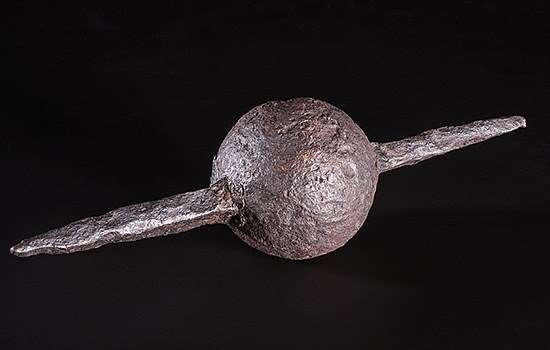
Life under siege at Goodrich Castle
The 17th-century objects found at Goodrich Castle help us to imagine what life at the castle was like during the Civil War siege. View some of them in detail here.
-
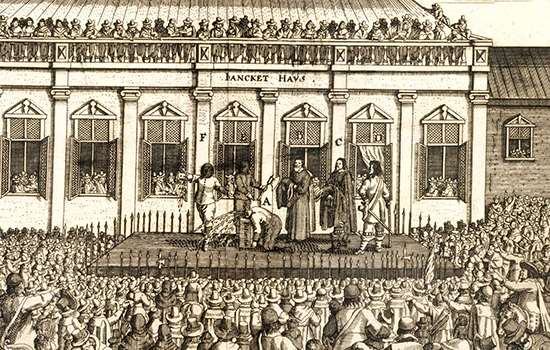
THE ENGLISH CIVIL WARS
Discover how the Civil Wars unfolded at English Heritage’s properties – from sieges to the Isle of Wight castle where Charles I was imprisoned.
-
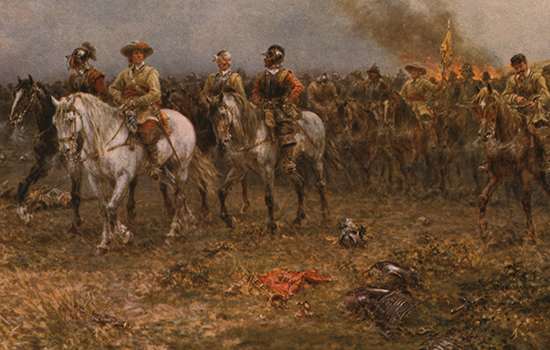
The Civil Wars Explained
Learn about what caused the Civil Wars, how they unfolded, and what their legacy was in this comprehensive guide.
-
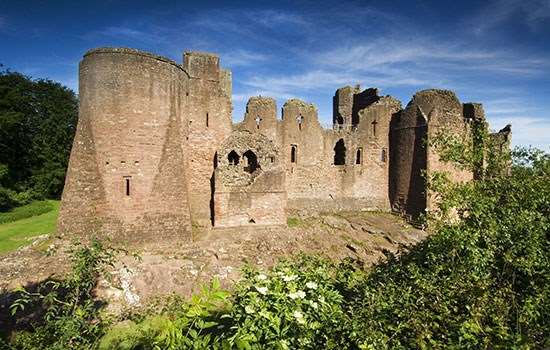
History of Goodrich Castle
Read a full history of Goodrich Castle, one of the best-preserved medieval castles in England, which was besieged and captured by Parliamentarians during the Civil War of the 17th century.
-
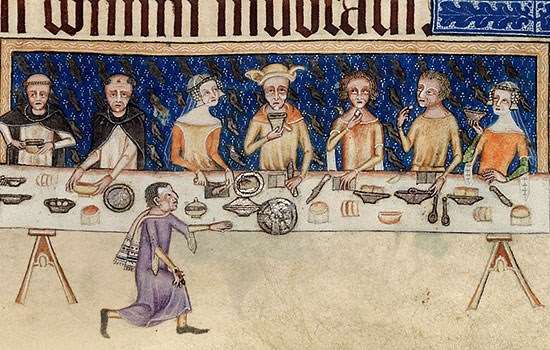
Life in a medieval household
Goodrich Castle was a thriving medieval household, where sometimes hundreds of people were living at any one time. Find out about some of the household members and their life at the castle.
-
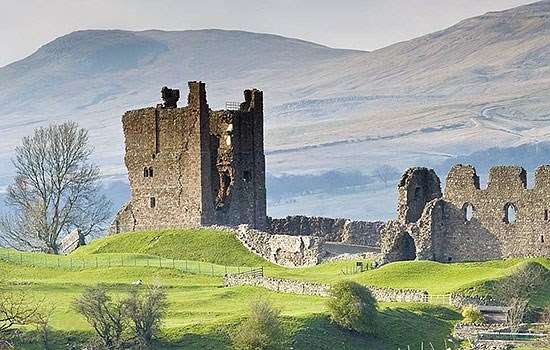
English medieval castles
Once symbols of power and prestige, England’s medieval castles are now monuments to centuries of history. Discover the stories held within their walls.
